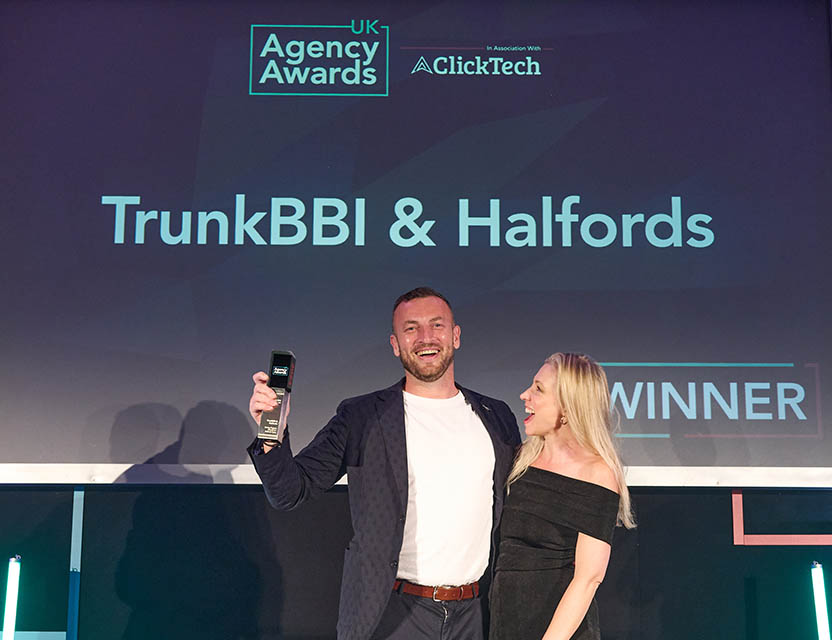How AI, accessibility, and video-ecommerce are shaping the future of SEO
We never miss an opportunity to level up our skills at TrunkBBI, so of course, we were eager to visit to London for the yearly Women in Tech SEO conference. Four female members of our stellar SEO team headed down to the Big Smoke for the all-women, full day SEO event.
Our team had the opportunity to listen to 10 incredible female speakers, gaining unique insight into the trends shaping the SEO industry in 2024. What did we learn? An awful lot – and so can you. Here’s our round up of our four favourite talks of the day.
SEO and PPC: A match made in heaven
The conference kicked off with a talk from Grace Frohlich, SEO Consultant at Brainlabs, where she dived into why a holistic approach is key for SEO and PPC. She highlighted that we don’t always know how to integrate the two together, especially since teams are typically either skilled in SEO or PPC, not both together.
To better integrate PPC with SEO, she advised of a four-step approach:
- Get to know your PPC team – see what they’re working on, including current campaigns and initiatives, and discuss challenges and pain points.
- See what SEO data you can share with the PPC team, including high-performing organic words, on-page optimisation results, search term reports from Google Ads (conversion rates and cost per conversion), audience insights, and landing page tests. You should also see what data PPC teams can share with SEO teams.
- Align team roadmaps together to create a joint channel with a clear overview of goals, tasks, and responsibilities. Get clear on your overarching goals, such as to increase revenue or improve brand awareness.
- Measure and report on your roadmap and discuss which metrics you want each channel to report on, such as sessions, impressions, and conversion rates. You should also create a combined dashboard with a visual overview of progress and results.
Turning clicks into revenue with video
The second talk of the day welcomed SEO Specialist Stevy Liakopoulou onto the stage for a talk on how we can turn clicks into revenue with video e-commerce strategy.
She emphasised that 90% of marketers have used video marketing and yielded positive ROI. She also explained how 87% of video marketers say video has directly increased sales, making it a clear path to focus on for SEO.
To set the scene, Stevy first explored why we should be using video. She discussed how video content can offer increased conversion rates, increased audience order value (AOV), and better customer attraction.
Videos can be a quick win because they’re shareable and clickable. They also turn watches into buyers, help build trust, elevate brand reputation, and allow users to see the value in your brand or products. For SEO purposes, embedded videos can increase user engagement, lower bounce rates, improve backlink opportunities, and help with Google rankings.
To drive results, brands should provide videos catering to different purposes, like answering users’ problems or delivering educational information about products. This includes video content such as:
- Demonstration videos
- Behind-the-scenes vlogs
- Unboxing videos
- Testimonial videos
- Comparison videos
- Lifestyle videos including product placement
In terms of SEO considerations, Stevy explained that teams should take a methodical approach to planning videos, thinking about the following:
- Keyword research to decide topic of video
- Choosing the right product
- Selecting which platforms and channels to use to promote the video
- How to add a compelling video thumbnail
- How to use closed captions to help with accessibility and translation
- How to add context with keywords, headings, and other FAQs
Bias in AI: Why it might be the solution
We weren’t surprised to hear a talk about AI at the 2024 event. After all, it’s been a hot topic of discussion for quite some time now. But this talk opened our eyes to something we hadn’t discussed before – bias.
The underlying theme of Founder and CEO of Inclued AI Joyann Boyce’s talk was that humans are biased, but generative AI might be even worse. If we’re using generative AI to create content, then we might actually be pushing even more bias into the world. However, she explained that we can use this to our advantage.
Her solution? She suggests starting with bias in mind. Accept that it’s not ideal, but see how you can help train it and create greater inclusivity. This means thinking about your audience more generally and creating content that represents the diversity of the brands that target this audience. To do this, she advised to focus on three things:
- Strategy: Audit where you currently are to gain an outsider’s (and non-biased) perspective of your strategy. Get their opinions on what you’re currently doing and could do to make your strategy more inclusive. This also means paying attention to accessibility.
- Visuals: Review your stock images, models, influencers, and illustrations. See how you can add more diversity, such as with skin tones. Many people are using AI to generate visual assets, so be sure to request greater representation and inclusivity in your prompts.
- Copy: See how you can add more inclusive language to your communications and be careful of using words that have other connotations.
Why technical SEO is important for accessibility
Last but by no means least, is Billie Geena Hyde’s talk on why technical SEO is critical for improved accessibility. Billie, SEO Consultant and Founder of Uptake Agency, emphasised that if your site is not accessible, you’re missing out on nearly 16% of users. Thankfully, improving accessibility isn’t a tough task. It’s something most SEO teams can increase with a few simple changes.
Tools
Billie advised to make use of tools such as Chrome plugins, colour contrasting analysers, and Sitebulb, which crawls your site for accessibility. You can also manually test your site with Chrome’s screen reader plugin which helps you understand how people who are visually impaired experience your page.
Site checks
Review your site accessibility by checking what your pages look like without Javascript enabled. You can also download a text-only browser to see how the page appears. See whether you can understand the difference between header, body, and footer text easily. Also, look at navigation functions with Javascript disabled and see whether you can navigate a page with just your keyboard and no mouse.
User experience
Finally, Billie explained that you need to assess various aspects of user experience to increase accessibility. This includes the following:
- Assess the cumulative layout shift (CLS) and see whether the page has flashing elements
- Make sure links are distinctive, especially from other text on the page
- Review the navigation to ensure it’s clear, including where it begins and ends
- Make sure buttons have a tap target of 40×40 pixels
- Zoom in to your page to see how it appears in larger view
- Optimise images to make sure they’re clear, easy to understand, and have the right level of colour contrast
- Make sure the contrast between text and background is significant
- Assess content readability to ensure your copy is easy to understand
Find out what SEO can do for you
If you’re looking to learn more about SEO or need advice on your business’ approach to organic search, get in touch with the TrunkBBI SEO team using the form below. Alternatively, call us on 0161 711 1000 to see how we can help scale up your business with engaging, relevant content for your audience that delivers results.



